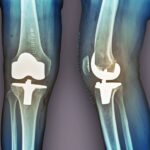Knee replacement surgery is one of the most successful orthopaedic procedures available today. Most patients report reduced or eliminated knee discomfort, greater mobility, and an overall improvement activities. This procedure may be recommended for someone with to minimal severe arthritis or a serious knee injury. In this article you will understand the basic difference between partial and total knee replacement.
Understanding partial and total knee replacement
Before learning the difference between partial and total knee replacement, you must understand their meaning. Here is a brief overview of both kinds of replacement.
Partial knee replacement
A partial knee replacement is a type of knee arthroplasty (joint replacement) that removes damaged tissue and bone in the knee joint and replaces it with an artificial implant. This surgery is typically performed when arthritis is present in only one part of the knee.
Partial knee replacements are usually performed with smaller cuts, meaning there is less recovery time. Patients can go up and down stairs as needed, but only with straight legs for the first two weeks after the procedure. After that, patients should have enough flexibility and muscle repair to walk relatively normally.
Total knee replacement
A total knee replacement is a surgical operation that involves replacing the whole knee joint with prosthetic components to alleviate pain and impairment. It is also referred to as knee arthroplasty or joint replacement.
A knee replacement surgeon performs a TKA by removing damaged components of the knee joint and replacing them with metal and plastic elements. The procedure, which typically lasts 60-90 minutes, is conducted while the patient is unconscious under general anaesthesia. Most patients stay in the hospital for one or two nights following surgery, and they can normally walk with help within a few days.
The key difference between partial and total knee replacement
Here is the key difference between partial and total knee replacement:
Extent of surgery
Partial knee replacement: A partial knee replacement is a surgery procedure that removes damaged bone and tissue from one part of the knee and replaces it with a prosthetic implant. The part of the knee that is replaced can be the inside (medial), outside (lateral), or kneecap.
Total knee replacement: A total knee replacement, also known as knee arthroplasty, replaces the damaged ends of the thighbone, shinbone, and kneecap with artificial parts made of metal and plastic.
Invasiveness
Partial knee replacement: A partial knee replacement is a less (minimally) invasive option than a total knee replacement.
Total knee replacement: A traditional total knee replacement surgery involves a large incision of about 8 inches over the knee, while a minimally invasive surgery uses a smaller incision.
Recovery Time:
Partial knee replacement: A partial knee replacement is a less (minimally) invasive option than a total knee replacement.
Total knee replacement: Recovery time after a partial knee replacement, also known as a unicompartmental knee replacement, typically takes about three to six weeks. Most people can walk without a cane or walker within 3 to 4 weeks after surgery and can start moving and walking with assistance right away.
Suitability:
Partial knee replacement: A partial knee replacement may be suitable for patients with arthritis in one part of the knee and if the pain is mainly on the inside or outside of the knee and not throughout the knee or under the kneecap.
Total knee replacement: Total knee replacement surgery is most suitable for people who are middle-aged or older, have arthritis in more than one knee compartment, and don’t plan to return to heavy labour or high-impact athletics.
How do you choose the right option?
When choosing between a partial or total knee replacement, you can consider factors like:
- Knee condition: A partial knee replacement is better if only one part of the knee has osteoarthritis. A total knee replacement is better if two or three compartments are damaged or if the patient has severe ligament instability or deformity.
- Patient age and overall health: These factors can also help determine the most suitable treatment plan.
- Personal circumstances and preferences: Discussing the risks and benefits of each procedure with a knee replacement specialist can help you choose what’s best for you.
Benefits of each type
Here are some benefits and considerations for each type of knee replacement:
- Total knee replacement (TKR)
- Benefits: Pain relief, functional restoration, long-term durability
- Considerations: Major surgery, risks associated with anaesthesia, infection, and blood clots, time-consuming recovery, activity restrictions during recovery
- Partial knee replacement (PKR)
- Benefits: Less invasive, faster recovery, more natural knee movement
- Considerations: Limited scope, risk of revision surgery, may need to be converted to a total knee replacement in the future
Knee replacement surgery is one of the most successful orthopaedic procedures available today. Consulting with an knee replacement surgeon is necessary to determine the best option based on individual health needs.
For more information and personalised advice, contact Dr Simon, the best knee surgeon in Delhi to live a healthy life. Restore your mobility and get back to your normal routine with total or partial knee replacement surgery.













